Speech-Language Resources
This topical guide will introduce you to important books, videos, and information resources available from the EI Clearinghouse and other sources. Contact us via online form or by phone (1-877-275-3227) to request a resource listed below (or ask your local public librarian). Note that some videos may be viewed online, and journal titles will take you to the publisher’s homepage.
Table of Contents

EIC Resources
Books
Sign language is a great way to communicate with kids. These beginner-friendly cards make ASL simple to learn and teach kids with helpful signs and fun ways to practice.
This book examines the effect of augmentative and alternative communication strategies on the communication, social skills, and behavior of individuals with autism.
This book provides practical, effective tools to teach your baby relevant signs such as “more,” “all done,” “milk,” and others, all while having fun.
Using trusted American Sign Language (ASL), this book is the go-to guide for parents, caregivers, and educators looking to create effective two-way communication.
This book helps therapists and parents learn how to help children become more vocal, verbal, communicative, imitative and interactive.
This book is full of activities to enhance children’s speech. It is designed for teachers and speech language pathologists.
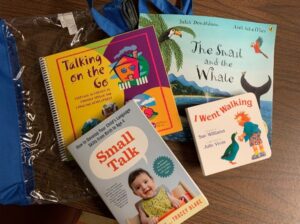
A kit that helps promote children’s language development through activities, images and stories.
Books include:
- I went walking / written by Sue Williams ; illustrated by Julie Vivas
- Small talk : how to develop your child’s language skills from birth to age four / Nicola Lathey and Tracey Blake
- Talking on the go : everyday activities to enhance speech and language development / Dorothy P. Dougherty, MA, CCC-SLP, Diane R. Paul, PhD, CCC-SLP
- The snail and the whale / by Julia Donaldson, pictures by Axel Scheffler
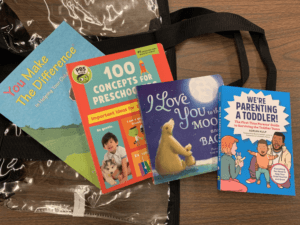
A kit that helps promote children’s language development through activities, images and stories.
Books include:
- We’re parenting a toddler! : the first-time parents’ guide to surviving the toddler years / Adrian Kulp ; foreword by Bunmi Laditan ; illustrations by Jeremy Nguyen
- I love you to the moon and back / written and illustrated by Tim Warnes
- 100 concepts for preschoolers : important ideas for 3 – 4 – year olds / Julie Merberg
- You make the difference : in helping your child learn / Ayala Manolson, M.Sc speech language pathologist ; with Barb Ward, M.Ed special educator ; and Nancy Dodington BA, family support worker ; illustrations by Robin Baird Lewis ; cartoons by Lee Rapp ; cover and title pages by Ilana Manolson.
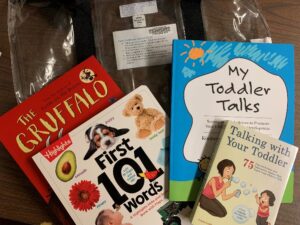
A kit that helps promote children’s language development through activities, images and stories.
Books include:
- Talking with your toddler : 75 fun activities and interactive games that teach your child to talk / Teresa Laikko, MS, CCC-SLP and Laura Laikko, MS, CF-SLP
- First 101 words
- The gruffalo / Julia Donaldson, pictures by Axel Scheffler
- My toddler talks : strategies and activities to promote your child’s language development / Kimberly Scanlon, M.A., CCC-SLP
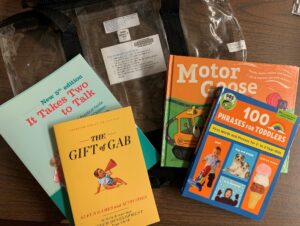
A kit that helps promote children’s language development through activities, images and stories.
Books include:
- The gift of gab / Francine Davids, MS, CCC-SLP
- 100 phrases for toddlers
- Motor goose / poems by Rebecca Colby ; illustrated by Jef Kaminsky
- It takes two to talk (new 5th edition) / Elaine Weitzman.
With step-by-step written instructions for tons of FUN and easy-to-implement activities, parents and professionals can be confident in their ability to successfully identify and then strengthen these 11 major skills that encompass all the important social, cognitive, receptive, and expressive milestones that verbal and communicative kids have mastered.
This book provides caregivers and parents with over 55 activities that are designed to enrich children’s speech and language abilities.
Learn sign language alongside your baby with an adorable storybook designed to encourage you to learn new words and signs as you read together.
This book is a layperson’s guide to understanding childhood apraxia of speech and the strategies that can help a child overcome obstacles to age-appropriate speech.
This book shows how to model and elicit language in toddlers. There are techniques for speech therapists to use in everyday life. This book is best designed for speech language pathologists, early intervention specialists, or other professionals.
This program includes assessments and examples of goals and outcomes, along with specific intervention strategies for facilitating development of the following five foundation skills: nonverbal imitation, joint attention and social referencing, sensory processing and self-regulation, purposeful play, early language development.
This book provides practicing SLPs the hands-on information they need to effectively treat toddlers, preschoolers, and early school-aged children who have or who are suspected of having childhood apraxia of speech (CAS).
This book is specifically for speech language pathologists trying to be more inclusive in their teaching. Some topics covered are collaborating with others, rethinking students, providing social supports, and more.
This textbook helps speech-language graduate students to evaluate, compare, select, and apply effective interventions for children with language disorders. The book examines 15 widely used interventions. It includes a DVD with video footage.
This book is an essential guide to language development, from babbling to first words to full sentences, plus early signs of anxiety, autism, or ADHD.
This book for professionals discusses the evidence base for parent and family involvement in different areas of speech-language pathology (SLP) clinical practice and also discusses the most effective ways of interacting with and involving parents in SLP intervention.
Videos and Media
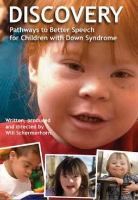
This film takes the viewer into the real world of speech in children with Down syndrome. Through examples, interviews and stories, the DVD shows how parents and professionals can bring forth better speech and communication.
This companion to the It Takes Two to Talk book provides video examples of activities parents and professionals can use to develop the language and communication skills of young children. Includes video examples of children at each stage of early language development, from those who communicate non-verbally to those who have begun to use short sentences. Presents the accounts of two mothers of children with language delays and their participation in The Hanen Program for Parents.
This DVD may be used by both parents and professionals to support preschool children with social and communication challenges, such as autism spectrum disorder. The DVD includes the research-based strategies parents can use in everyday activities to foster their children’s communication skills.
Presents normal infant development with emphasis on hearing, speech, and language development. The video also discusses the credentials and services of speech language pathology and audiology. Age-specific milestones are addressed. This video is for parents and professionals and provides examples of normal speech, language, and hearing development, as well as tips on when parents should seek treatment.
This self-study video focuses on communication and assessment methodologies and strategies for toddlers and school-age children. Through the case studies of two children with ASD, the video provides theoretical and research background, as well as evidence-based information and practical examples.
Learn simple strategies for working with young children with speech sound disorders. The key diagnostic characteristics of suspected apraxia of speech and phonological disorders will be presented as well as characteristics which lead to differential diagnosis for each of these speech disorders. Successful strategies for working with toddlers and young preschoolers are discussed and then highlighted with dozens of “real life” therapy clips.
In this recording, you will learn to recognize and demonstrate 100 basic signs, the manual alphabet, and numbers from 1-20 as well as how to incorporate them into your practice immediately.
Organizations
The American Academy of Audiology is the world’s largest professional organization of, by, and for audiologists.
This website contains information about conferences for speech pathologists and audiologists. There are also many resources about speech and audiology available on this site.
ASHA is a professional association for speech-language pathologists and audiologists. This site contains numerous resources, including topic-specific guides, continuing education opportunities, ASHA publications, articles, an online store, and the latest research. ASHA Special Interest Groups were created to promote specific professional interests among members, develop communication and networking in diverse professional settings, identify and convey concerns and needs to the Association’s governance, and assist in policy formation.
Part of the U.S. Department of Health and Human Services, the NIDCD supports biomedical research into hearing and communication disorders. The NIDCD site contains a great deal of information for professionals, including consumer health information, the latest research, and grant and funding opportunities.
Articles
This article describes an early intervention program designed for use by speech-language pathologists, preparing them to work with birth to 5-year-old children and their families in a family-centered and interdisciplinary manner.
This article presents promising practices for speech-language pathologists to use while collaboratively developing and implementing early intervention plans for children with ASD and their families.
For young children with autism spectrum disorder, research indicates that intervention provided before age 3 has a much greater impact than intervention provided after age 5. This is consistent with early intervention research with other populations.
Early, consistent reading demonstrates improved language scores as early as 9 months of age. This article discusses the results of a small, single institution study that looked at how setting minimal daily reading expectations impacted daily reading compliance early in life.
This article presents a study that examined the relationship between young children’s prelinguistic communication behaviors and subsequent expressive and receptive language outcomes.
This article describes how ASHA practice policies and documents support the SLP role in EI
This article condenses the ASHA document Roles and Responsibilities of Speech-Language Pathologists (SLPs) in Early Intervention: Guidelines.
Web Resources
This resource, from the American Speech-Language-Hearing Association, provides tips to promote children’s speech development. The activities are organized by children’s ages (birth to 2 years, 2 to 4 years, and 4 to 6 years).
This page describes communication skills and milestones and provides examples of activities for caregivers to support a child’s communication development.
This 2007 position statement from the Joint Committee on Infant Hearing lists principles and guidelines for early hearing detection and intervention programs.
This portion of the ASHA Web site is devoted to professionals who are interested in or are participating in an early intervention program.
This portion of the CDC Web site provides information for families and health professionals. The site contains statistics, research, and resources, including information about the Early Hearing Detection and Intervention (EHDI) programs and an online parent guide to infant hearing loss.
Learn how children learn to develop the skills necessary to develop language and literacy early in their life.
Practice Guides with adaptations give ideas on how to make literacy learning activities accessible for young children with disabilities.
Medline is a consumer health information resource from the U.S. National Library of Medicine. This page contains information on speech and communication disorders, including the latest research, dictionaries, glossaries, statistics, introductions to specific diagnoses, and treatment options.
Some children start kindergarten with double the vocabulary of others. Knowing many words and understanding them are important in developing thinking skills and in getting ready to read.
It’s happening again! You’re running errands with your children and suddenly you’re stuck—in traffic, at the clinic, in the checkout line. Many parents find that playful learning activities can help reduce children’s impatience when they have to wait.

